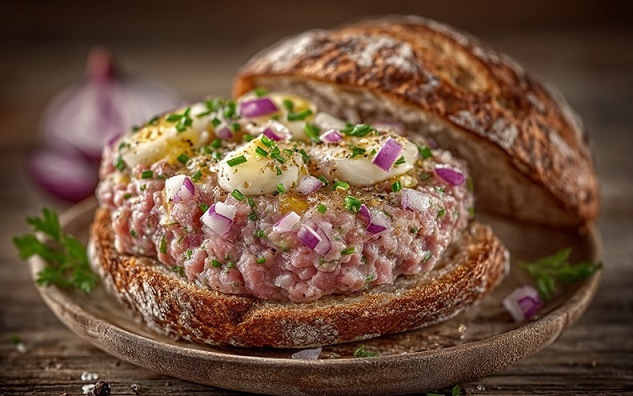
Few German foods spark more curiosity – or controversy – than Mettbrötchen. This traditional sandwich of raw minced pork on a bread roll may seem unusual to outsiders, but in Germany, it’s a beloved breakfast item and pub snack with deep roots in local culture.
Whether topped simply with onions or garnished with pepper and salt, Mettbrötchen is a staple in butcher shops and bakeries across the country. In this guide, we’ll explore the history of this unique dish, its safe preparation, and a step-by-step recipe to make your own Mettbrötchen at home.
The Origins of Mettbrötchen Recipe
Mettbrötchen comes from the word “Mett”, meaning seasoned raw minced pork, and “Brötchen”, meaning bread roll. The dish emerged in the early 20th century as a quick, protein-rich snack, particularly in Northern and Central Germany.
It was popularized by butchers, who offered it fresh and seasoned right from the counter. Mett has long been associated with German breakfast culture, especially in Lower Saxony, Saxony-Anhalt, and the Ruhr region.
Despite its simplicity, Mettbrötchen is bound by strict freshness and hygiene standards. In Germany, raw pork can be safely consumed when sourced from trusted butchers and consumed the same day.
Ingredients for Authentic Mettbrötchen
To enjoy Mettbrötchen at its best, start with fresh, high-quality ingredients. The quality of the meat is crucial.
Ingredients:
- 200g fresh pork Mett (raw minced pork, ideally from a German-style butcher)
- 2 fresh crusty German bread rolls (Brötchen or Kaiser rolls)
- 1 small white onion, finely chopped
- Sea salt, to taste
- Freshly ground black pepper, to taste
- Optional: Chives, paprika, pickles, or mustard
Tools:
- Sharp knife for chopping
- Clean cutting board
- Serving plates
- Optional: Cold packs if serving outside for freshness
Substitutions:
- If you can’t access traditional Mett, look for freshly ground pork shoulder with at least 30% fat, free from preservatives.
- For bread, a crusty sourdough or rustic roll will work.
How to Make Mettbrötchen (Step-by-Step Instructions)
Step 1: Source Fresh Pork Mett
Buy your pork on the same day you plan to eat it. The meat should be finely ground, well-chilled, and sourced from a reliable butcher or meat counter.
Step 2: Season the Mett
In a clean bowl, mix the minced pork with salt and pepper. For a traditional touch, sprinkle a pinch of paprika. Some Germans also like to add a touch of caraway or garlic, but this is optional.
Step 3: Prepare the Onions
Peel and finely chop the white onion. Use raw for a sharp flavor, or soak briefly in cold water for a milder bite.
Step 4: Assemble the Brötchen
Slice the rolls in half horizontally. Spread the seasoned Mett generously over each half, smoothing it evenly.
Step 5: Garnish and Serve
Top with the chopped onions and an extra pinch of salt and pepper. Garnish with chives or a slice of pickle if desired. Serve immediately while the meat is cold and the bread fresh.
Safety Tips:
- Consume within a few hours of preparation.
- Keep the meat refrigerated until serving.
- Only use pork labeled suitable for raw consumption (Schweinehackfleisch zum Rohverzehr in Germany).
How to Serve Mettbrötchen
Mettbrötchen is best enjoyed fresh, typically as part of a hearty German breakfast, midday snack, or cold platter (Kalte Platte) at social gatherings.
Traditional Accompaniments:
- Pickles or radishes
- Bavarian pretzels or rye bread on the side
- German potato salad
Drink Pairings:
- Light German beers (like Pilsner or Kölsch)
- A glass of crisp apple cider
- Sparkling mineral water with lemon for a clean contrast
Variations & Regional Twists
Northern Germany:
Mettbrötchen is often topped with raw onions and sometimes chopped pickles or mustard.
Central Germany:
The meat may be mixed with onion, garlic, and salt in advance and shaped into decorative forms like hedgehogs (Mettigel).
Modern Variations:
- Add a slice of aged cheese (like Emmental) for extra richness.
- Mix in finely chopped herbs, such as parsley or thyme.
- Serve on dark rye or vollkornbrot for a more rustic twist.
While it might surprise the uninitiated, Mettbrötchen is a cherished part of Germany’s culinary identity – simple, flavorful, and steeped in butcher-shop tradition. With careful sourcing and attention to hygiene, it’s easy and safe to prepare at home.
For safety-related discussions, you can read more in the article: Is Mettbrötchen Safe to Eat?
Whether you’re looking for an authentic taste of Germany or planning a unique brunch, Mettbrötchen delivers bold flavor with minimal effort.
Curious to explore more German classics? Try our recipes for German Pretzels, Obatzda Cheese Spread, or Potato Salad for the full German table experience!
Related Articles
Mettbrötchen – Raw Minced Pork Sandwich
Learn how to make authentic Mettbrötchen at home with this step-by-step guide, including ingredients, safety tips, and serving suggestions.
Mettbrötchen: Germany’s Raw Pork Sandwich Explained
Discover the origins, preparation, and cultural significance of Mettbrötchen – a raw pork sandwich loved across Germany.
Is Mettbrötchen Safe to Eat?
Worried about eating raw pork? This article explains why Mettbrötchen is safe in Germany – and what precautions matter most.
The Cultural History of Mettbrötchen
From butcher counters to breakfast tables, explore how this raw pork sandwich became a symbol of German culinary tradition.
What’s in a Mettbrötchen? Ingredients and Regional Tips
Find out what really goes into a Mettbrötchen, including ingredient choices, regional variations, and modern serving ideas.
Mett vs. Hackepeter: What’s the Difference?
Understand the key differences between Mett and Hackepeter – two raw pork dishes with unique flavors and regional identities.
Why This Raw Pork Sandwich Terrifies Americans (But Germans Love It)
Explore the cultural divide between Germany and the U.S. over Mettbrötchen – a dish celebrated in one country and feared in another.
10 Surprising Facts About Mettbrötchen
Think you know Mettbrötchen? These fun facts reveal hidden quirks, surprising history, and what makes this dish a German classic.







